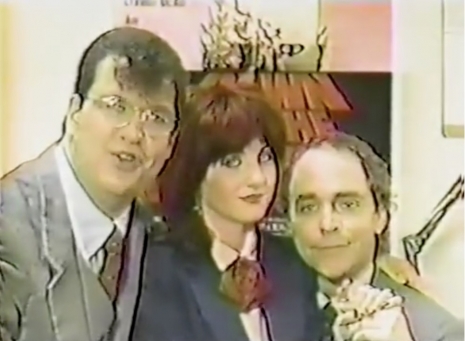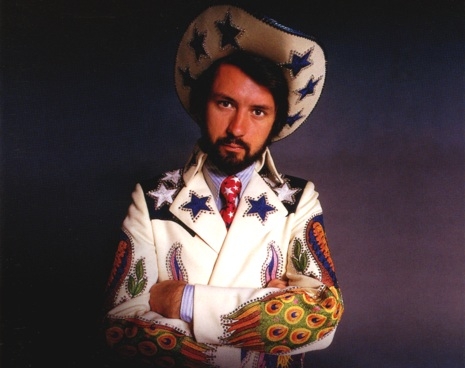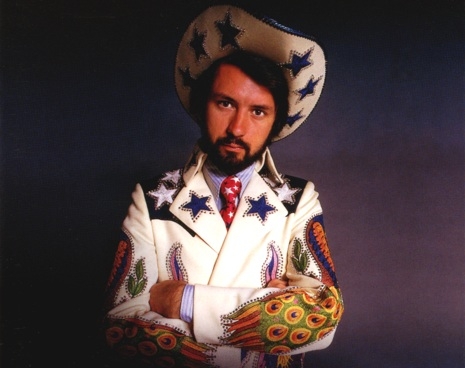
Emilio Estevez on the set of ‘Repo Man.’
Alex Cox was thirty-years-old when he took on the task of directing his first feature-length film, 1984’s Repo Man. It’s a film which seems to perfectly encapsulate gonzo journalist Hunter S. Thompson’s apocalyptic quote “Too weird to live, and too rare to die” as it nears its 35th anniversary this March.
Unlike what the ravages of the aging process does to most of us mortal types, Cox’s film endured and remains as defiantly DIY as does its equally angry soundtrack, containing venomous jams from the Circle Jerks, Iggy Pop, and Suicidal Tendencies. However, Cox faced an uphill battle while trying to shop Repo Man around because nobody outside of actor and writer Dick Rude understood what the fuck the film was supposed to be about. Rude had approached Cox with his short story Leather Rubbernecks, hoping to make it into a short film but ultimately Leather Rubbernecks would become a part of Repo Man, as did Rude in his role of sushi chew and screwer Duke in the movie. At some point, the Repo Man script would end up in the hands of former Monkee and visionary in his own right, Michael Nesmith. According to folklore, Papa Nez was instantly impressed and stepped into the role of Executive Producer for the film because, as we all know, Papa Nez gets it and helped Cox (a former repo man in real life) bring Repo Man to the big screen.
Wild stories surrounding this timeless film have been discussed and dissected by writers, film historians, and scholars since its release. A few weeks ago I cracked open my copy of Criterion’s impeccable 2013 release of the film and rewatched it in all of its pissed-off glory. Of the film’s vast merits, which are too numerous to lay out in this post (all of the repo men are named after domestic beer brands, and so on, and on), let’s focus on what many consider to be Harry Dean Stanton’s best acting performance as unhinged repo man Bud (a play on the gross suds known as Budweiser).
Stanton was 58 when he took on the role of Bud (which almost went to Dennis Hopper) and had long since established his alpha hangdog status in Hollywood starring in films with elite actors like Paul Newman, Jack Nicholson, and Donald Sutherland. Stanton didn’t waste any time letting everyone know, especially Alex Cox, what he was and was not going to do during filming. Within a few days, he was already refusing to learn his dialog for the film. Stanton supported his decision by citing actor Warren Oates who Stanton claimed read his lines off of cards stuck to a car dashboard while filming 1971’s Two-Lane Backdrop. All of Stanton’s complaints finally set Cox off and the director began to think it might be easier to cut their losses by writing Stanton out of any future scenes. With Nesmith’s support he shut down Cox’s quest to make Bud disappear and eventually, Stanton delivered his lines without skipping a beat. But that didn’t mean Stanton suddenly became some sort of fucking choir-boy after almost getting ghosted by Cox. And this time his bad-boy behavior involved baseball bats.
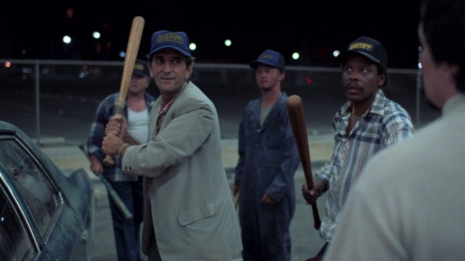
Stanton and his trusty baseball bat.
For a scene involving Otto (played by a 22-year-old Emilio Estevez), Stanton pitched the idea of using a modified baseball hand signal used in a scene to tell Otto where to park a car. Cox said no, and Stanton went off telling Cox that other “great” directors he had worked with like Francis Ford Coppola let him do “whatever the fuck he wanted.” Later in a scene where Stanton was to act aggressively with a baseball bat at competing repo dudes the Rodriguez brothers, Stanton requested he be able to use a real baseball bat claiming he could do the scene in one take. The film’s cinematographer, Robby Müller, didn’t get behind the idea of arming Stanton with a baseball bat for the scene and was afraid the combination of an unruly Harry Dean Stanton and a baseball bat equaled bad times for someone’s head or worse. When Stanton was told he would have to switch out his Louisville slugger for a plastic version he went batshit and allegedly screamed the following in response:
“Harry Dean Stanton only uses REAL baseball bats!”
The quote “Harry Dean Stanton only uses REAL baseball bats!” is on par with Dennis Hopper’s terrifying endorsement in Blue Velvet for Pabst Blue Ribbon and it’s regretful at best that no footage of Stanton screaming these words seems to exists. In closing, I would highly recommend picking up a copy of the Criterion release of Repo Man as, in addition to a fantastic booklet full of illustrations by Cox and Mondo artists Jay Shaw and Tyler Stout. I’ve included all kinds of cool visual artifacts from Repo Man below including rare photos taken on the set, vintage German and Japanese lobby cards and posters, and some of the gritty neon artwork from the Criterion release.

Michael Nesmith and Harry Dean Stanton on the set of ‘Repo Man.’

A candid shot on the set of ‘Repo Man’ of Emilio Estevez, his father Martin Sheen, Harry Dean Stanton and Alex Cox.
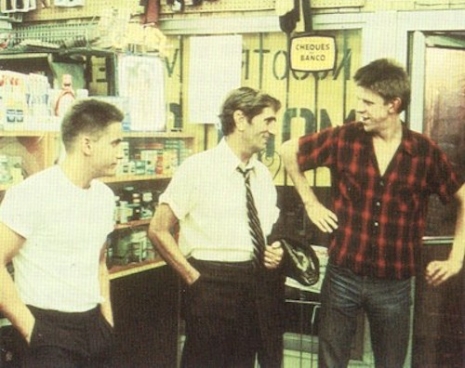
Estevez, Stanton, and Cox.
Continues after the jump…






